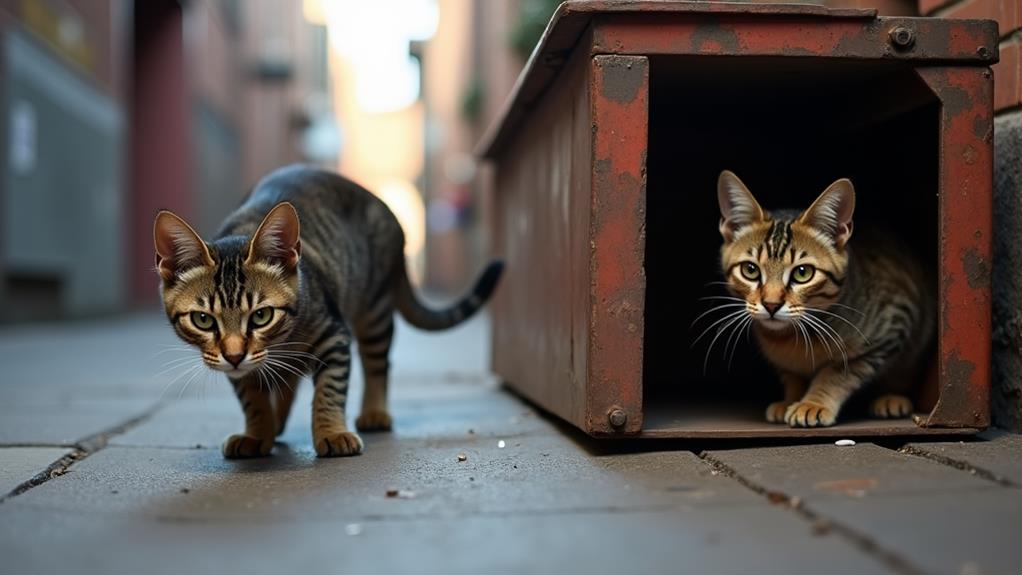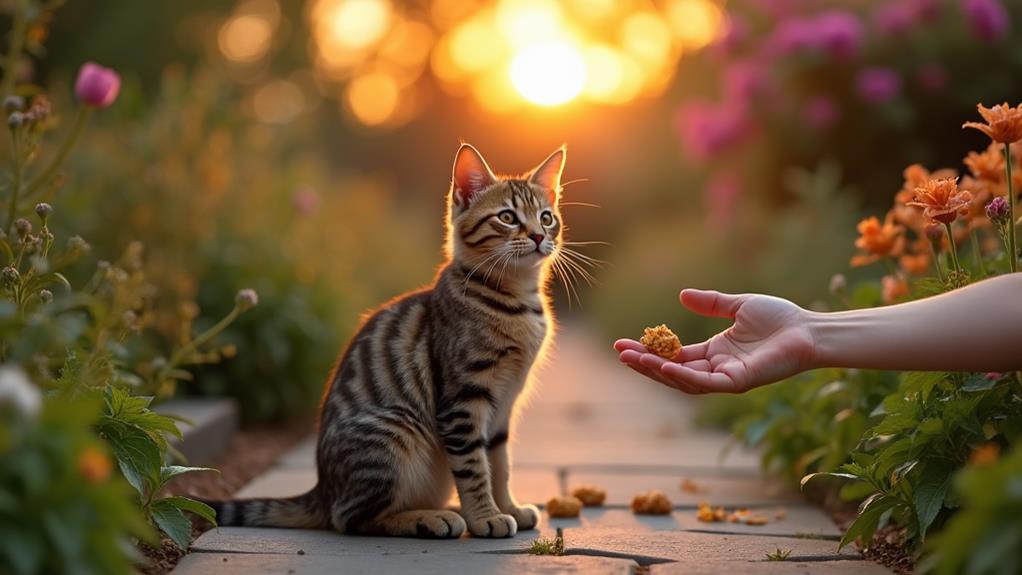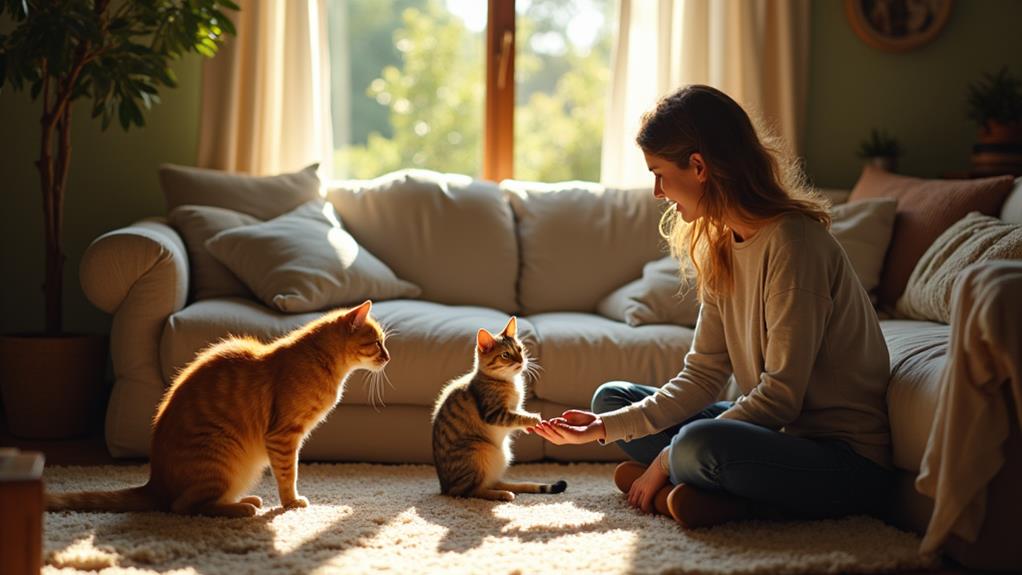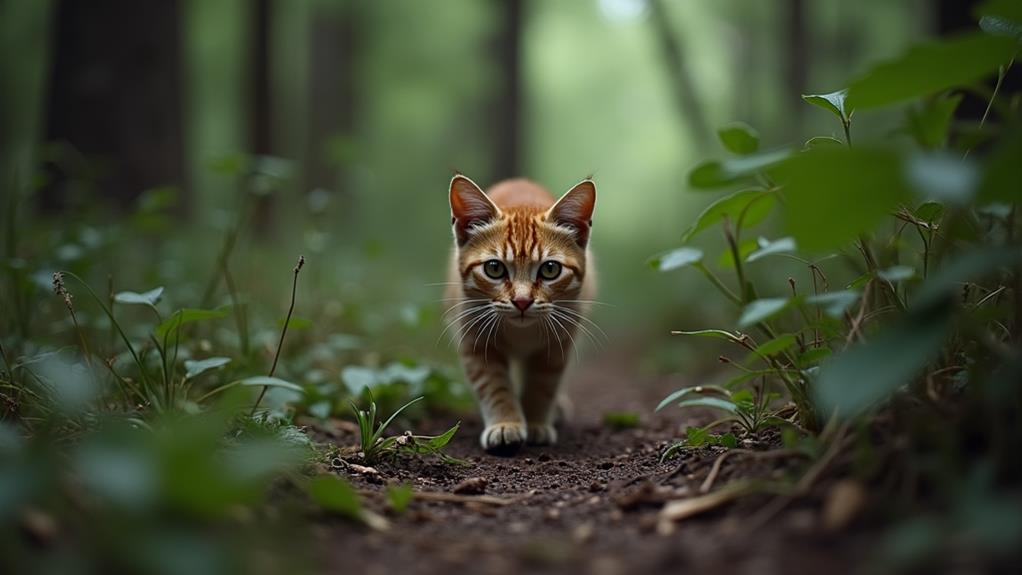How Does a Cat Become Feral? Understanding Their Journey

A cat becomes feral when it grows up without early human contact, missing vital socialization in its initial 12 weeks. Without this interaction, the cat develops wary and cautious behavior, evolving into a skilled survivor to fend for itself outdoors. Factors like genetics, irresponsible pet ownership, and the environment play a role in this transformation. Unlike stray cats, which might still seek human companionship, feral cats avoid humans and often form colonies for mutual survival. They exhibit permanent mistrust of people, making adoption challenging. Investigate the nuances of this expedition and uncover effective strategies for managing feral populations.
The Journey to Feral Life
In the path to feral life, a cat often begins its way when it's born outdoors without early human contact, missing essential socialization periods, particularly before 12 weeks of years. During this critical developmental stage, kittens need consistent interaction with humans to develop trust and social skills. Without it, these cats grow wary and cautious, adapting to life without the comforts of human companionship.
As you observe feral cats, you'll notice their distinct lack of interest in human interaction. This behavior roots from their early life experiences where human contact was nonexistent or minimal. These cats learn to rely on their instincts, which guide them in maneuvering the challenges of outdoor life. They become adept hunters and survivors, thriving in environments that might seem harsh or unwelcoming.
The lack of early socialization cements their independent nature. Unlike domesticated cats, feral cats establish complex social structures within colonies, where they communicate and cooperate for survival. Their path to feral life is a transformation shaped by their early environment and absence of human bonding. Understanding this path helps highlight the significance of responsible pet ownership and early socialization to prevent the growth of feral populations.
Factors Influencing Feral Behavior
Several key factors shape feral behavior in cats, with early life experiences playing a crucial role. When kittens don't experience consistent human interaction before they're 12 weeks old, they often develop fear and mistrust of humans. This lack of early socialization is a primary reason why many feral cats aren't easily socialized to people. They typically grow up in environments where human contact is minimal, fostering a wild disposition similar to other wild animals.
Irresponsible pet ownership greatly contributes to growing feral cat populations. Unneutered cats breed unchecked, forming colonies that expand rapidly. Implementing neuter and return programs can help control these populations by preventing further reproduction while allowing cats to live out their lives in familiar territories.
Genetic predisposition can also influence feral behavior. Some cats have a natural inclination to avoid human interaction, especially those from long-term feral lineages. Environmental factors like food availability and the presence of human shelters also play a role in shaping feral behavior. Cats in areas with abundant resources may be less wary of humans, while those in harsher conditions might be more elusive and independent, further hindering efforts to socialize them.
Stray vs. Feral Characteristics

Understanding the distinction between stray and feral cats is vital for anyone dealing with these animals. Stray cats are typically lost or abandoned pets that have had some level of socialization with humans. They often seek human companionship and may even approach people, showing friendly behaviors like purring or rubbing against legs. On the other hand, feral cats are unsocialized and have had little to no contact with humans. These felines are usually wary of people, often displaying fearful or aggressive behaviors to maintain their distance.
Stray cats might allow brief touches or interactions, signaling their past socialization experiences. If a stray cat experiences prolonged isolation, it can revert to feral behavior, becoming more skittish and wary of humans. Feral cats, however, tend to resist any physical contact and are quick to retreat when approached. They're generally unsuitable for indoor living due to their strong fear of humans.
While stray cats might live solitarily, relying on humans for food and shelter, feral cats often form colonies. These social structures help them survive in the wild, highlighting a significant difference in how these two groups of cats navigate their environments.
Socialization and Human Interaction
Socialization skills play a crucial role in determining a cat's comfort level with humans. To nurture these skills, kittens need consistent human interaction before they hit the 12-week mark. Without exposure during this critical period, they might grow up fearing humans. This is often the case with feral cats, who are usually born outside and never experience early human contact. These cats become naturally wary and resistant to socialization efforts later in life.
Stray cats, on the other hand, are typically lost or abandoned pets. They can revert to feral behavior if they go too long without human interaction. This reversion underscores the significance of early and ongoing socialization. For adult feral cats, the lack of human interaction results in a lifelong fear of humans, making them unsuitable for indoor adoption. Unfortunately, such circumstances can lead to euthanasia unless they're managed through alternatives like TNR programs.
To assess a cat's socialization level, observe their behavior. Stray cats might display friendly behaviors, while feral cats often show fearful postures. Understanding these behaviors helps us differentiate between socialized and feral cats, guiding our approach to their care and management.
Effective Management Strategies

Effective management strategies for feral cats focus on humane and sustainable solutions that benefit both the cats and the community. One of the most effective methods you can support is implementing TNR programs. These programs involve trapping feral cats, having them spayed or neutered, and then returning them to their colony. This approach not only reduces reproduction rates but also promotes healthier colonies. By preventing the birth of feral kittens, TNR programs help manage the population while maintaining the cats' quality of life.
Educating the community about responsible pet ownership and the importance of spaying or neutering pets is vital. This knowledge helps address the root causes of feral behavior and prevents future overpopulation. Partnering with local shelters and veterinary services to offer low-cost neutering can make a significant difference, especially in urban areas where feral cat issues are more pronounced.
Additionally, providing insulated shelters and ongoing feeding guarantees feral cats are protected from harsh weather conditions. Regular monitoring and support from community volunteers are fundamental for maintaining the well-being of these colonies. This includes making sure they receive vaccinations and medical attention, reducing the spread of disease and improving general health.




